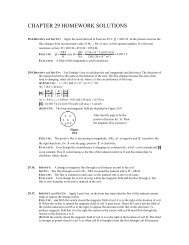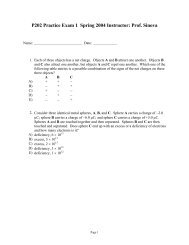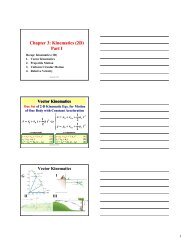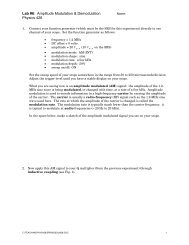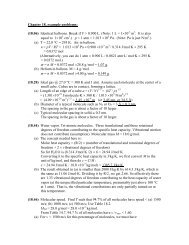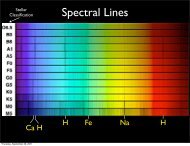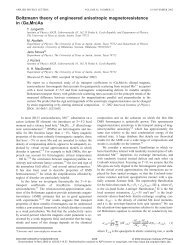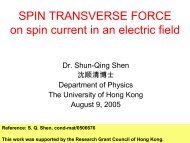Dynamics of Rotational Motion
Dynamics of Rotational Motion
Dynamics of Rotational Motion
You also want an ePaper? Increase the reach of your titles
YUMPU automatically turns print PDFs into web optimized ePapers that Google loves.
• A force applied ata right angle to alever will generatea torque.• The distance fromthe pivot to thepoint <strong>of</strong> forceapplication islinearlyproportional to thetorque produced.Torque: Angular force
Lines <strong>of</strong> force and calculations <strong>of</strong> torquesJust like moment <strong>of</strong> inertia, torque is alwaysmeasured with respect to a point/axis aroundwhich the object rotates (Pivot Point)Magnitude <strong>of</strong> torque is given by:The direction <strong>of</strong> the torque is given by the RHR€τ = rF sinθ = rF tanTorque <strong>of</strong> force F wrt. applied a distance r away:τ = r × F€
Newton’s 2 nd Law in angular sense:Σ τ = Iα is just like Σ F = maMoment <strong>of</strong> inertia AROUND thesame PP (O in the figure)∑τ= Iαzz€Sum <strong>of</strong> torques on a rigid objectAROUND a PP (O in the figure)The label z is to remind you that the actual torque and angular velocity vectorpoint perpendicular to the x-y plane defined by the force and the leverage armThis angular equation is IN ADDITION to any linear force which moves the center <strong>of</strong>mass but as long as the axis <strong>of</strong> rotation is fixed we do not need to worry about thelinear motion. This changes when the rotating object is also moving
Flywheel problem from Ch 9(using work energy theorem)The cable is wrapped around a cylinder. If it unwinds 2.0 m by pulling it with aforce <strong>of</strong> 9.0 N and it starts at rest, what is its final angular velocity andvelocity <strong>of</strong> the cable? (use work energy theorem)W total= KE f− KE iFΔx = 1 2 Iω 2 − 0€€ω =2FΔxI= 4FΔxmR 2= 20 rad/sv = Rω = (20 rad/s)(0.060 m) =1.2 m/s
Flywheel problem using torque(using work energy theorem)The cable is wrapped around a cylinder. If it unwinds 2.0 m by pulling it with aforce <strong>of</strong> 9.0 N and it starts at rest, what is its final angular velocity andvelocity <strong>of</strong> the cable? (use work energy theorem)I = 1 2 MR2τ = FR = (9.0 N)(0.06 m)€€τ = Iα ⇒ α = τ I = 2FRMR 2 = 2FMR= 6.0 rad/s2Use α to get acceleration <strong>of</strong> the cable:a tan= Rα = (0.06m)(6.0 rad/s 2 ) = 0.36 m/s 2Then use kinematicsv 2 = v 0 2 + 2a tan(x − x 0)€v =0 + 2(0.36 m/s 2 )(2 m) =1.2 m/s€
What is the velocity <strong>of</strong> the blockwhen it hits the ground?The work done by the cable is zerosince the two tension forces canceleach other out so energy is conservedKE i+ PE i= KE f+ PE f€0 + mgh = 1 2 mv2 + 1 2 Iω 2 + 00 + mgh = 1 2 mv2 + 1 ⎛⎛ 1 ⎞⎞⎜⎜2 ⎝⎝ 2 MR2 ⎠⎠⎟⎟ ⎛⎛ v ⎞⎞⎜⎜⎝⎝ R ⎟⎟⎠⎠2+ 0v =2mgh(m +M/2)€
Another look at the unwinding cableWhat is the linear acceleration <strong>of</strong> the block?€€These are two coupled objects; one rotatesand the other moves linearlyFor the rotating wheel we have:τ = IαTR = 1 ⎛⎛ a ⎞⎞2 MR2 ⎜⎜ ⎟⎟ ⇒ T = 1 ⎝⎝ R⎠⎠2 MaFor the block we have:mg − T = maCombine the two equations to getmg − 1 2⇒ a =Ma = mamgm + M /2
A rigid body in motion about a moving axisWhen an object is moving and rotating at the same time we canshow that the total kinetic energy is:KE = 1 2 mv 2cm+ 1 2 I cmω 2€That is, there are two parts, the motion <strong>of</strong> the center <strong>of</strong>mass and the rotation about the center <strong>of</strong> mass. Keepin mind that it is ONLY ABOUT THE CENTER OFMASS when this applies. Any other point <strong>of</strong> rotation itwill not work.
Rolling with and without slippingWhen rolling without slipping then€KE = 1 2 mv 2cm€v cm= RωThen, if you are rolling without slipping the kinetic energy is+ 1 2 I cmω 2 = 1 2 mv 2cm+ 1 2This is the condition to rollwithout slipping.I cmR 2 v2Also note that when one is rolling without slipping (i.e. rolling down anincline) the friction force is static so no work is done by it and energy isconserved in this case.
Consider the speed <strong>of</strong> a yo-yo toyWhat is the speed <strong>of</strong> the Yo-yo at the bottom (use conservation <strong>of</strong> energy)Why conservation <strong>of</strong> energy: the hand is not moving so itdoes no work on the system. You may be confused aboutthe tension but keep in mind that it is an internal force sothe sum <strong>of</strong> the upper and lower tension is zero.E i= E f0 + Mgh = 1 2 Mv 2cm0 + Mgh = 1 2 Mv 2cm+ 1 2 I cmω 2+ 1 ⎛⎛ 1 ⎞⎞ ⎛⎛⎜⎜2 ⎝⎝ 2 MR2 ⎟⎟ v ⎞⎞cm⎜⎜ ⎟⎟⎠⎠ ⎝⎝ R ⎠⎠2Mgh = 3 4 Mv 2cm⇒ v cm=4 3 gh€
The race <strong>of</strong> objects with different momentshLet’s figure out which circular object has the largest velocity when it reaches thebottom <strong>of</strong> the ramp. They roll without slipping so energy is conserved.E i= E f0 + Mgh = 1 2 Mv 2cm0 + Mgh = 1 2 Mv 2cm+ 1 2 I cmω 2+ 1 2 I ⎛⎛cm⎜⎜⎝⎝Mgh = 1 2 (1+ I cmMR )Mv 22 cm⇒ v cm=2ghv cmR⎞⎞⎟⎟⎠⎠2= 1 2 Mv 2cm+ 1 2I cmMR v 22 cm1+ I cmMR 2 €v sphere cm=v ring cm=v cylinder cm=2gh1+ 2 5= 10gh72gh1+1 = gh2gh1+ 1 2= 4gh3
Combined translation and rotation: dynamicsWhen an object is moving and rotating then the dynamics are determined byconsidering the linear acceleration <strong>of</strong> the center <strong>of</strong> mass and the rotation aboutthe center <strong>of</strong> mass (i.e. the torques considered are around the center <strong>of</strong> mass)∑ F = ma cm∑ τ z= I cmα z€
The yo-yo (again)This time let’s calculate the accelerationThe linear Newton’s equation read:y :∑ F y= Ma cm −y€Mg − T = Ma cm+The rotational Newton’s equation read:θ :τ z ∑= Iα z+--τ Mg+τ T= Iα z0 + RT = 1 2 MR2 a cmRT = 1 2 Ma cm⇒Mg − 1 2 Ma cm = Ma cma cm= 2 3 g
€Consider the acceleration <strong>of</strong> a rolling sphereThe linear Newton’s equations read:x :y :∑F x∑ F y= 0= ma cm −xMgsinβ − F f −stat= ma cmF N− Mgcosβ = 0The rotational Newton’s equation read:θ :∑€τ z= Iα zτ FN+τ Mg+τ fric= Iα z0 + 0 + RF f= 2 5 MR2 a cmR⇒ Mgsinβ − 2 5 Ma cm= Ma cmF f= 2 5 Ma cma cm= 5 7 gsinβ
Work and power in rotational motionWork done by a torqueWork done by a any torqueW τ=θ 2∫θ1τ zdθWork done by a constant torqueW τ= τ z(θ 2−θ 1)€€Power delivered by a torqueP τ= dW dt= τ zω z€
Angular MomentumRecall that torque was defined asτ = r × FSimilarly the angular momentum <strong>of</strong> a particle isAlso, just as before for linear momentum we can show that the rate <strong>of</strong> change<strong>of</strong> the angular momentum on a particle is equal to the torque on that particledLdt = d dt ( r × m v ) = d rdt × m v + r × m d vdt = v × m v + r × ma = 0 + r × F€⇒ τ = d LdtFOR A RIGID BODY ONE USES THE MOMENT OF INERTIATO DEFINE THE ANGULAR MOMENTUM€L = r × p = r × m v€L = I ω€
Conservation <strong>of</strong> angularmomentumBefore we saw that if the external forces on a system are zero thenlinear momentum is conserved. Similar for angular momentum.If the external torques on a system are zero then the TOTAL angularmomentum <strong>of</strong> the systems is conserved.Note that in this case the TORQUE has to be zero. There can be stillforces acting on the system but they do not generate any torque (e.g.force due to gravity on the cat which acts at the center <strong>of</strong> mass)I 1ω 1= I 2ω 2
How a car’s clutch workThe clutch disk and the gear disk ispushed into each other by two forcesthat do not impart any torque, what is thefinal angular velocity when they cometogether?L z−before= L z−afterI Aω A+ I Bω B= (I A+ I B)ω final⇒ω final= I Aω A+ I Bω B(I A+ I B)
Angular momentum conservation in collisionsA door 1.00 m wide, <strong>of</strong> mass 15 kg, is hinged at one side so that it can rotatewithout friction about a vertical axis. It is unlatched. A police <strong>of</strong>ficer fires a bulletwith a mass <strong>of</strong> 10 g and a speed <strong>of</strong> 400 m/s into the exact center <strong>of</strong> the door, in adirection perpendicular to the plane <strong>of</strong> the door. Find the angular speed <strong>of</strong> thedoor just after the bullet embeds intelf in the door.L z−before= L z−afterm Bv Bl = (I door+ m Bl 2 )ω fm Bv Bl = ( 1 3 Md 2 + m Bl 2 )ω f⇒ ω f=m Bv Bl( 1 3 Md 2 + m Bl 2 )= 0.4 rad/s
Exercise 10.16A 12.0-kg box resting on a horizontal, frictionless surface is attachedto a 5.00-kg weight by a thin, light wire that passes without slippageover a frictionless pulley (the figure ). The pulley has the shape <strong>of</strong> auniform solid disk <strong>of</strong> mass 2.10 kg and diameter 0.600 m. Find thetensions in the cables and the acceleration.Problem worked out in class
Exercise 10.20A string is wrapped several times around the rim <strong>of</strong> a small hoopwith radius 8.00 cm and mass 0.180 kg. The free end <strong>of</strong> thestring is held in place and the hoop is released from rest. Afterthe hoop has descended 90.0 cm, calculate the speed <strong>of</strong> itscenter <strong>of</strong> mass.Problem worked out in class
Exercise 10.22A hollow, spherical shell with mass 2.25 kg rolls without slipping down aslope angled at 31.0 degrees. Find the acceleration, the frictional forceand the minimal coefficient <strong>of</strong> static friction to prevent it from slipping.Problem worked out in class
Exercise 10.39Under some circumstances, a star can collapse into an extremely denseobject made mostly <strong>of</strong> neutrons and called a neutron star. The density <strong>of</strong> aneutron star is roughly 10 14 times as great as that <strong>of</strong> ordinary solid matter.Suppose we represent the star as a uniform, solid, rigid sphere, both beforeand after the collapse. The star's initial radius was 6.0×10 5 km (comparableto our sun); its final radius is 17 km. If the original star rotated once in 32days, find the angular speed <strong>of</strong> the neutron star.Problem worked out in class
Exercise 10.70A thin-walled, hollow spherical shell <strong>of</strong> mass m and radius r starts from restand rolls without slipping down the track shown in the figure . Points A and Bare on a circular part <strong>of</strong> the track having radius R. The diameter <strong>of</strong> the shellis very small compared to h 0 and R, and rolling friction is negligible. What isthe minimum height for which this shell will make a complete loop-the-loopon the circular part <strong>of</strong> the track?Problem worked out in class
Gyroscopic precession• The precession <strong>of</strong> agyroscope shows up inmany “common”situations.



